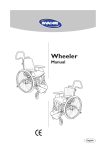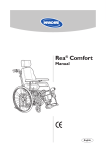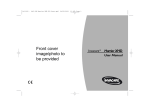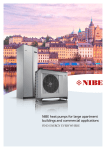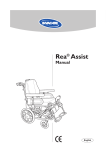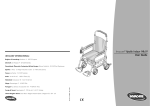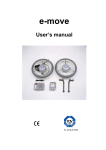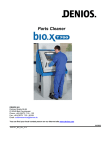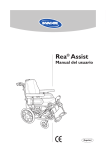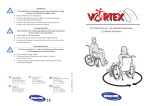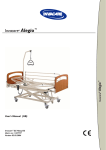Download Vortex - Invacare
Transcript
Vortex User's manual English VORTEX 1 2 VORTEX Vortex You have now taken delivery of a new wheelchair with Vortex. For optimal use and suitability to your needs, we hope that your wheelchair has been tested for you by an authorised person. This means that the wheelchair has been adjusted according to your requirements, taking into account your weight and other personal needs. We presume that these adjustments have been made and that you have also received instructions and advice on how to use your wheelchair in your everyday life. Please read through this instruction manual before starting to use your Vortex wheelchair. It is full of good advice and adjustment possibilities. Vortex is a power driven auxiliary motor which is activated by the handrims. Vortex has been tested and approved at TÜV in Germany in combination with the following wheelchairs: REA Comfort, Adapt, Spirea XLT, Rea Bellis and Rrea 703 LX. We hope that you will be fully satisfied with your Vortex wheelchair. NB!!! ! Read the back page of this instruction manual. The text covers a number of points regarding your own personal safety. Please read it carefully! Invacare Rea AB only takes responsibility for product alterations carried out by personnel we authorise. We reserve the right to make equipment and specification changes without prior notice. DELIVERY CHECK Check that all components comply with the delivery note. Any damage incurred during transport must be reported immediately to the transport company. Retain all packaging until the transport company has checked the consignment and an agreement has been reached. Please notify Scandinavian Mobility if an accident or similar incident occurs when this product is used. VORTEX 3 Contents The Vortex system ...............................................................5–6 Assembly...............................................................................7–17 Transport and disassembly ............................................18-19 Technical specifications ......................................................... 20 Area of use ............................................................................... 21 Product description................................................................ 21 Guarantee and maintenance................................................. 22 Battery ................................................................................ 22-27 Troubleshooting ..................................................................... 28 Operating the wheelchair ..................................................... 29 Sound guide ............................................................................. 30 Guide to safe operation .................................................31-33 4 VORTEX The Vortex System A E F B C D Vortex consists of the following components: A. Drive wheel B. Battery C. Battery cover D. Battery charger The control switch (E) and the battery holder (F) are located on the right-hand drive wheel. VORTEX 5 A 6 B Two models of the Vortex system Type A – is designed for users who have a strong grip and cover long distances by themselves. Type A has an assist ratio of 1.5. Of the total energy supply required, the user supplies approximately 40% and Vortex approximately 60%. Type B – is designed for users with a somewhat weaker grip. Of the total energy supply required, the user supplies approximately 25% and Vortex approximately 75%. You can see which version you have simply by looking at the handrims. Type A has polished/stainless steel handrims and type B has black plastic covered ones. There is also a number in the battery holder, e.g. XA4G. If the fourth character is “G” you have type A and if the fourth character is “H” you have type B. VORTEX Assembly New chair with Vortex system 1. The Vortex system and the wheelchair are delivered in separate packaging. A Vortex wheels 1. Start by fitting the Vortex wheels to your wheelchair. The wheels are quick release (QR). 2, Start by opening out the handle (A) for the quick release mechanism (Figure 1). 2. 3. When you fit the right-hand wheel, you must lift the wheelchair slightly with your left hand whilst keeping your right hand under the battery holder to prevent it rotating (Figure 2). Then insert the QR axle (B). Figure 3. It is very important that the axle is pushed in far enough. If not, the QR axle may break. See figure 3 (D). 3. D VORTEX 7 1. Cable A 1. Then, cable (A), which hangs loose in the righthand wheel, must be put into the socket (B). It is important that the cable is placed so that the arrow on the cable is above the small dash on the socket. B 2. Battery 2. The battery supplied should already have been charged. Remove the protective cover and simply place the battery into the battery holder as indicated in figure 2. 8 VORTEX 1. Anti-tip device 1. The anti-tip device is fitted on the wheelchair when delivered and must always be used on a Vortex wheelchair. If you have ordered an Adapt or XLT chair and requested fitting of the Vortex wheels in a special position, you may find that a shorter type of anti-tip device has been fitted on the right-hand side. This has been done seeing as the original anti-tip device interferes with the battery holder. See the illustrations above. Adapt 2. XLT 1. Vortex as an assembly set for previously delivered wheelchairs 1. If you have bought the Vortex system only – without a chair – there are a few components you must fit to enable you to fit the Vortex wheels to your wheelchair. A 2. Fitting the centre plate B VORTEX Spirea 2. If your Spirea chair does not have a position plate, you must fit one to it. The position plate is included in the assembly set. Start by loosening the two screws (A) and removing the drive wheel attachment. The position plate is attached with two bolts (B) as shown in the diagram. 9 3. Then fit the centre plate (C) as shown. 3. C A 4. Adapt (diagram 4) 4. To fit Vortex onto an Adapt chair, you must turn the position plate (A) to obtain 0° cambring. You cannot have cambring as this would cause the wheels to catch on the armrests.The centre plate (B) is then fitted as shown in the diagram. B 1. XLT U+V (diagram 1) 1. The centre plate (A) is fitted as shown. A 2. 10 XLT Box-frame (diagram 2) 2. First unscrew the screws and remove the existing drive wheel plate. VORTEX 3. Then fit the new plate with the same screws. The plate can be fitted in two different ways, depending on the required seat height. 3. 4. REA Comfort The centre plate (A) is fitted as shown. 4. A 1. 1. REA 703 LX Unscrew the screws and remove the existing position plate. 2. 2. Then fit the new plate with the same screws. The centre plate C is fitted as shown in the diagram. C 3. 3. REA Bellis Fit the centre plate D as shown in the diagram. D VORTEX 11 1. Vortex wheels 1. The wheels are quick release (QR). Start by opening out the handle (A) for the quick release mechanism (Figure 1). 2. 2. When you fit the right-hand wheel, you must lift the wheelchair slightly with your left hand whilst keeping your right hand under the battery holder to prevent it rotating (Figure 2). Then insert the QR axle (B). Figure 3. 3. 3. It is very important that the axle is pushed in far enough. If not, the QR axle may break. See figure 3 (D). D B 12 VORTEX 1. Anti-tip devices 1. You must always have anti-tip devices on your Vortex wheelchair.The anti-tip devices are included in the assembly set. Three anti-tip devices are included in the assembly set for Adapt chairs; two regular ones and one shorter one. The shorter version must be used on the right-hand side when the position plate (A) is fitted as shown in Figure 1. A standard anti-tip device would knock the battery holder. 2. VORTEX 2. If the position plate is fitted according to Figure 2, the standard anti-tip device can be used. 13 1. 1. Four anti-tip devices are included in the assembly set for XLT chairs; two standard versions and two longer ones with different attachments. The longer anti-tip devices (see Figure 1) must be used if the wheels are to be fitted in the lower row of holes on the position plate (A). 2. 2. The standard anti-tip devices (see Figure 2) must be used if the wheels are to be fitted in the uppermost row of holes on the position plate. 3. 14 3. The anti-tip device for XLT Box is fitted as shown in diagram 3. VORTEX 1. REA 703LX 2. REA Bellis 1. The anti-tip device for the REA 703LX is fitted as shown in diagram 1. 2. The anti-tip device for the REA Bellis is fitted as shown in diagram 2. C 1. Fitting brakes A D A VORTEX 1. Due to the fact that you place a centre plate onto the drive wheel plate, the wheels extend further than on a standard chair. In order for the brakes to work properly, you must extend the brakes with brake spacers. B Spirea and Adapt Start by loosening the two screws (A) and removing the brake. Then the three spacers (C) must be fitted as shown. The brake pin (D) must be moved to outermost hole. Retighten the screws. 15 C 1. XLT U+V-frames 1. Start by loosening the two screws (A) and removing the brake.Then fit the two brake spacers (C) as shown and retighten the screws. A B A 2. D XLT Box-frame 2. Unscrew the four screws and adjust the cross tube (D) sideways and lengthways. Re-tighten the screws. 3. REA Comfort 3. Start by loosening the two screws (E) which keep the brake in place.Then place the brake spacer (F) in between, and retighten the screws. B 16 VORTEX 1. 2. REA Bellis 1. Unscrew screw A and remove the brake. Then fit three additional spacers (C) as shown in the diagram. Fit the new longer screw and tighten it securely. C A REA 703LX 2. 2. Unscrew screw B and remove the brake. Then fit three spacers (D) as shown in the diagram. Fit the new longer screw and tighten it securely. D B 1. Cable A 1. Then, cable (A), which hangs loose in the righthand wheel, must be put into the socket (B). It is important that the cable is placed so that the arrow on the cable is above the small dash on the socket. B 2. Battery 2. The battery supplied should already have been charged. Remove the protective cover and simply place the battery into the battery holder as indicated in figure 2. VORTEX 17 Transport and disassembly 1. Your Vortex chair is easy to get ready for transport. A 2. Battery 1. Remove the battery by pressing button (A) whilst carefully pulling the battery out of its holder (Figure 1). Cable 2. Remove the cable from the socket by turning it whilst pulling it carefully upwards (Figure 2). 1. Wheels 1. The wheels are removed by opening out the handle (A) to the quick release mechanism and pulling straight outwards. (Figure 1). Take care when removing the right-hand wheel. The battery holder and switch can easily start to rotate if you do not hold one of them whilst loosening the wheel (Figure 2). 2. 24” wheels 2. You can easily replace the Vortex wheels with regular 24” quick release drive wheels. Open out the handle (A) and carefully pull out the wheel (Figure 1). For instructions on how to fold the actual wheelchair, please refer to the wheelchair instruction manual enclosed with the delivery. 18 VORTEX 1. 1. For instructions on how to adjust the backrest, seat, etc. please refer to the wheelchair instruction manual enclosed with the delivery. A 2. Angle adjustment of the battery holder 2. Loosen the screws (A, figure 1). Tilt the battery holder to the desired position and retighten the screws. Angle adjustment of the switch lever Loosen the screws (A, figure 2). Then adjust the lever to the desired position and retighten the screws. B VORTEX 19 Technical specifications Weight of the Vortex system: 16kg (including battery) Range: approximately 15km (depending on temperature and terrain) Speed: 0–6kph Motor: 24V 90Wx2 Tyre dimensions: 24 x 1 3/8 Battery type: Nickel Metal Hydride, 24V x 6.7 (AH) Fuse: 30A (flat) Battery charger: Capacity: 100 to 240V AC, 50/60Hz Calculated power: 37V, 26A (during charging) Charging time: Normal charging approximately 2–3 hours Reconditioning: approximately 3–13 hours Storage temperature: 0–40°C Increased chair width (cm): REA Comfort +5 Adapt –1 Spirea +5 XLT +5 REA Bellis +5 20 VORTEX Area of use Vortex is a rim activated motor unit for manual wheelchairs. Each hub has a motor gear system. By pushing the rims the motors are activated and will help the user to propel the chair. The Vortex is suitable for all users of rear wheel driven manual wheelchairs. When the user pushes the rims the Vortex motor will take over much of the energy needed to move the chair.The Vortex propelling system is suitable to be used indoors and outdoors. The Vortex battery capacity will depend on where the chair is used e.g. surface, temperature, etc. For normal conditions the battery should last for a normal day’s use. Because of the extra power the Vortex gives the user, there is a risk of tilting in uphill situations. Max. user weight 125 kg. Product description The Vortex propelling system is produced in two models. Each Vortex wheel has a 24V DC motor mounted in the hub.The two motor units are connected by a cable. Micro chips steer the energy use between the two wheels and align differences in power between the arms. The battery is a NiMH type (Nickel Metal Hydride) which is today’s Best Available Technology. The NiMH batteries have a very high capacity and low environmental impact. VORTEX 21 Guarantee and maintenance Guarantee: • • • The wheelchair is guaranteed for 3 years from the delivery date. The battery has a 6 month function guarantee. The machinery has a 1 year guarantee. Maintenance: • • • • • • • • Do not spray water onto the machinery Wipe clean the wheel axles and lubricate them with a little oil. Tighten the spokes once a year. Check nuts and screws regularly and tighten them when necessary (this applies to all lose parts). Wipe the frame with a soft cloth and detergent. Check over the chair once a week and check that no cracks or other damage have occurred. If any damage occurs, please contact Invacare immediately. All technical servicing must be carried out by an authorised person or Invacare Service. Only original components or those which meet Invacare*s specifications are to be used. Battery Before charging When you want to charge the battery, select a location which is: • Indoors and well ventilated • 0–40°C • A level and stable surface Warning! • • • • • 22 It is important that the temperature is 0–40°C. Do not place the charger near a cooker or in direct sunlight. The charger will not start if the temperature is too high or too low. Do not charge the battery where there is a risk of the equipment getting wet. Risk of short-circuiting and electric shocks. Do not place anything onto or extremely close to the battery charger when it is charging. The charger may overheat and stop working. Ensure that no children or pets touch the charger. Risk of electric shocks or damage to the equipment. Do not use any other type of charger. Only use the one enclosed in the delivery. VORTEX 1. Charging the battery A B Put one end of the lead (A) in the charger (B), as shown in figure 1. The other end is put into a 100–240V socket.* Then carefully place the battery into the charger. There are two types of charging processes; quick charging and reconditioning. The battery must be reconditioned from time to time to ensure optimum battery life and to avoid deterioration of battery capacity. See the section on reconditioning, opposite page. Quick charging 1) Place the battery in the charger. If the battery is at the correct temperature 0–40°C, the green charging light (A, fig. 2) will come on. The battery will be fully charged 2–3 hours later (the charging process may take longer if the battery is charged in a very warm or cold place). 2) If the battery temperature is too high (over 40°C) or too low (under 0°C), the green charging light (A, fig. 2) will flash until the battery temperature becomes suitable. The charging process will then start automatically. 2. A 3. 3) The capacity lights (B, figure 1) on the battery indicate the stage in the charging process. 4) When the process is complete, the charging lights and the battery’s capacity light go out automatically. B NB! Do not charge a battery which is already charged as this will shorten its life. Reconditioning When reconditioning, discharging and charging are carried out automatically. As the battery is first discharged completely and then charged, the battery life will be extended. 4. C D 1) Place the battery in the charger. 2) If the battery requires reconditioning, the yellow reconditioning light will flash (C, figure 2). If the red start button (D, figure 2) is pressed whilst the reconditioning light flashes (for about 10 seconds), the reconditioning light will come on and the reconditioning process will start. 3) The battery’s capacity lights indicate the stage in the charging process in the same way as during quick charging. Reconditioning time varies according to battery capacity. The process takes approxi-mately 3–13 hours. VORTEX 23 1. B Charging problems If the battery or charger develop any faults during charging, the green charging light and the reconditioning light on the charger and/or the battery’s capacity lights will start to flash. 1. The charging light and the reconditioning light flash simultaneously (figure 1): • Faulty battery. Replace the battery with a new one. A 2. C B 2. The fourth capacity light on the battery starts to flash (figure 2): • Faulty battery. Replace the battery with a new one. The charging light (A) and reconditioning light (B) flash at one second intervals: • A • This may be a contact fault. Check whether there are dust or other particles between the charger and the lead. A fuse may have blown. Open the fuse box on the side of the battery and check that everything works. If not, replace the blown fuse with the spare one stored on the side of the battery cover. Warning! Use the indicated fuses only (30A fuse flat) to avoid the risk of the battery catching fire. 24 VORTEX 1. 1. The first, third and fifth capacity lights flash (figure 1): • The battery is not at a temperature suitable for charging. Wait until the battery is at a suitable temperature before you charge it. 2. 2. The charging light and the reconditioning light on the charger flash in intervals green– green–yellow or green–green–green–yellow (figure 2): • Faulty charger. Replace the charger with a new one. 1. After charging 1) Remove the battery from the charger when the charging process is complete. Always store the battery with its protective cover fitted (figure 1). 2) Pull out the plug. Recycling used batteries Despite the fact that this type is the most environmentally adapted battery on the market, we recommend that you hand your batteries in for recycling. Battery capacity 2. A VORTEX 2. When you press the indication button (A, figure 2) on the battery, the lights indicate the battery’s capacity in 5 stages.The lights go out automatically after approximately 5 seconds. 25 1. The battery’s capacity lights look like this: This indicates: 1, If the battery is used regularly from being fully charged, the lights will go out one by one. 2. 3. 2. When only one light is on, the battery must be charged soon. 3. Time to charge the battery! The battery has an extremely low remaining capacity. Replace it or charge it immediately. Important! If you have to replace a battery whilst using your chair, make sure that the brakes on both wheels are locked before you replace the battery to prevent the wheel-chair moving. 1. If some but not all of the capacity lights come on when you press the indication button on a fully charged battery, this means that the battery has deteriorated and its capacity has been reduced. Battery capacity when you press the indication light. Four lights on 1. Deterioration: Although the battery’s capacity has decreased to 60%-80% of its initial capacity, it is still usable. 2. 2. Do this: If it is important for you to cover long distances without needing to charge the battery, you should replace it. Three lights on Deterioration:The battery’s capacity has decreased to 60% of its initial capacity and is barely usable. Do this: Replace the battery with a new one. Important! Contact your supplier for advice if only 3 lights are on after charging and the battery is less than one year old. 26 VORTEX Battery storage • • • • • • • VORTEX Do not store the battery in the holder on the wheelchair when the chair is not in use. Store the battery indoors with the protective cover on. Do not store the battery where there is a risk of it getting wet or being exposed to direct sunlight. If the battery is to be stored for a long time, charge it and store it where it is not too hot or too cold. Do not leave the battery outside in the cold or inside a warm car for long periods of time. Store the battery out of reach of children. If the wheelchair has been driven on a wet surface and the machinery has become wet, wipe it with a dry cloth to prevent certain components from rusting. 27 Troubleshooting Problem Check the following Action The chair runs sluggishly • Is the battery charged? • Charge the battery or replace it. • Has the battery been placed into the holder correctly? • Place the battery into the holder correctly. • Have you touched the control lever by mistake? • Press the button again. If it still runs sluggishly, contact your supplier. • Has the system switched off automatically? • Switch off the system and switch it on again. • Is there enough air in the tyres? • Pump up the tyres. • Is the wheel loose? • Put it into place correctly. • • Contact your supplier. • Can an abnormal sound be heard coming from the driving machinery? Is the battery fully charged? • Recharge or replace the battery. • Has a fuse blown? • Replace the fuse. • Has the battery been charged in a suitable environment? • Recharge the battery in a suitable place. The lights do not come on hand after you have charged the battery • Is the temperature around the battery and charger suitable? • Try to recharge the battery when the charger and battery are at a suitable temperature. If all of the battery lights do not come on after recharging, the capacity has de-creased due to battery deterioration. Charging stops abruptly • Is the battery fully charged? • Check the battery’s capacity lights. Charging is never completed • Is the temperature suitable? • Abnormal vibration The battery has a short range 28 The charger becomes extremely warm • Wait until the charger and battery are at a suitable temperature. Contact your supplier. The charger emits a strange odour or abnormal sound • Contact your supplier. VORTEX Operating the wheelchair Activation of the system 1) Apply the brakes. 2) Activate Vortex by pressing button (A) on the right-hand side of the chair. You will then hear a “beep” noise, and the system will be activated within three seconds. If you apply force to the handrims whilst switching on the power, you will hear a warning signal (long “beep” sound) and the wheelchair will not start. Switch the power off and on again without moving the handrims. Then wait until the system has been activated before you apply force to the handrims. 3) Release the brakes. 4) Make sure you know how the wheelchair works before starting to operate. Read the chapter Guide to safe operation” (page 38–40). VORTEX 29 Important • • • • • • • • If you propel your wheelchair applying the same amount of force as for a normal manual wheelchair, you will notice that, thanks to the Vortex system, each push will take you much further. Be careful in the beginning when using your wheelchair until you have learnt how it operates. Always switch off the power and apply the brakes when you want to get in or out of the wheelchair. Do not touch the switch when using the wheelchair except for when you want to stop. If you switch off the power when the wheelchair is moving quickly, the chair will stop very abruptly which may create a risk of you falling out of the chair. Do not balance a Vortex chair on the drive wheels using the handrims. This starts the electric motors and you will find it difficult to keep your balance. The handrims may become slippery, which may make steering the chair difficult if your hands are wet or if you use the chair in the rain. If you do not move the handrims for five minutes, the system switches off automatically to save the battery. Remember that the Vortex system increases the width of your wheelchair by approximately 5cm. This may prevent you from going through narrow doorways which did not previously cause any problems. Remember that the point of balance is changed on Vortex chairs compared with other models as the battery is fitted on the rear of the chair. Sound guide beep (a short sound) 1. When the system is activated. A light comes on (on the inner side of the wheel) for approximately three seconds). 2. When the system switches off automatically as you have not operated the chair for 5 minutes. beep–beep–beep–beep– beep–beep–beep–beep– beep–beep–beep–beep– beep–beep–beep–beep– (four short repeated sounds) The battery is starting to run out. A light on the inner side of the wheel starts to flash slowly. beep———————— (a continuous sound) 1. The battery has run out. (The light on the wheel comes on.) 2. Problems with the electronics (the light on the wheel comes on.) 3. When the power is switched on whilst you move the handrims. (The light on the wheel flashes rapidly.) 4. No contact between the right and left wheel. (The light flashes rapidly.) 30 VORTEX Guide to safe operation 1. When you receive your chair it is important that you select a safe place where it is not busy to check how the chair works. Take an assistant with you to be on the safe side. 1. Start/Stop • Push the handrims forward slowly and carefully. • Be careful so that the chair does not tip up when starting. 2. 2. Turning • Practise turning around a certain point to learn how the motor reacts. 3. 3. Braking • The motors also help when you want to apply the brakes. Simply push the handrims backwards slightly. • Practise braking when using the wheelchair at different speeds. VORTEX 31 32 1. 1, Lifting the castors • If you need to lift the castors when the motors are on, you must not touch the handrims. Hold the tyres instead. • It is best to switch off the power and then hold the handrims as usual. 2. 2. Going up steps • One way of getting up low steps is to go backwards. 3. 3. Upward and downward slopes • Ensure that the chair does not tip over when you go uphill. • The chair will keep to a constant speed on downward slopes. Select a speed which allows you to stop easily. • Do not have the power switched off on downward slopes. This may cause the wheelchair’s speed to increase to such an extent that you will find it difficult to stop. VORTEX 1. 2. 3. VORTEX 1, Slopes • Practise using your wheelchair on sloping surfaces. Proceed very carefully. 2. Crossings and pavements • Take plenty of time when using a pedestrian crossing. • Ensure that you do not drive into kerbs. • Ensure that the castors do not get stuck in the tracks when you use a railway crossing. 3. Manual operation • If you switch off the power, the chair will work just like a normal manual wheelchair. 33 34 VORTEX VORTEX 35 ! Warning. If the instructions are not followed, injury to the user and/or damage to the wheelchair may result. • • • Always use the anti-tip device. Do not lift the chair by the battery, battery holder, cable or handrims. Do not let children or people not familiar with Vortex use the chair. Manufacturer: Invacare Rea AB Växjövägen 303 S-343 75 DIÖ SWEDEN Sales companies: Holland: Denmark: Italy: Invacare A/S Sdr. Ringvej 39 DK-2605 Brøndby Tel. +45 - 36 90 00 00 Fax. +45 - 36 90 00 01 France: Invacare Poirier S.A Les Roches F.37230 Fondettes Tel. +33 - 02 47 62 64 66 Fax. +33 - 02 47 62 64 10 Germany: Invacare GmbH Dehmer Strasse 66 D-32549 Bad Oeynhausen Tel. +49 - 57 31 754 0 Fax. +49 - 57 31 754 150 36 Invacare B.V. Celsiusstraat 46 / P.O. Box 123 NL-6710 BC Ede Tel. +31 - 318 695757 Fax. +31 - 318 695758 Mecc san SARL Via Ddei Pini, 64 IT- 36016 Thiene VI Tel. +39 - 445 380059 Fax. +39 - 445 380034 Norway: Spain: Invacare S.A C/Areny, s/n Polígon Industrial de Celerá S- 17460 Celrá (Girona) Tel. +34 - 972 493200 Fax. +34 - 972 493220 Sweden: Invacare AB Fagerstagatan 9 / Box 66 S-163 91 Spånga Tel. +46 - 8 761 70 90 Fax. +46 - 8 761 81 08 Invacare AS Grensevingen 9 P.O. Box 6230 / Etterstad N-0603 OSLO 6 Tel. +47 - 22 57 95 00 Fax. +47 - 22 57 95 01 Switzerland: Portugal: United Kingdom: Invacare Lda Rua Senhora de Campanhâ PT- 4369-001 Porto Tel. +35 - 12 510 59 46 Fax. +35 - 12 510 57 39 küshall design ag Ringstrasse 15 CH- 4123 Allschwil Tel. +35 - 12 510 59 46 Fax. +35 - 12 510 57 39 Invacare (UK) Ltd. South Road, Bridgend Industrial Estate Bridgend County Borough of Bridgend CF31 3PY United Kingdom Tel.: +44 1656 664 321 Fax.: +44 1656 667 532 ManualVorEng10 02.03/Råd & Resultat Kommunikation i Ljungby AB Belgium: Invacare n.v. Autobaan 14 B-8210 Loppern, Brügge Tel. +32 - 50 83 10 10 Fax. +32 - 50 83 10 11 VORTEX







































